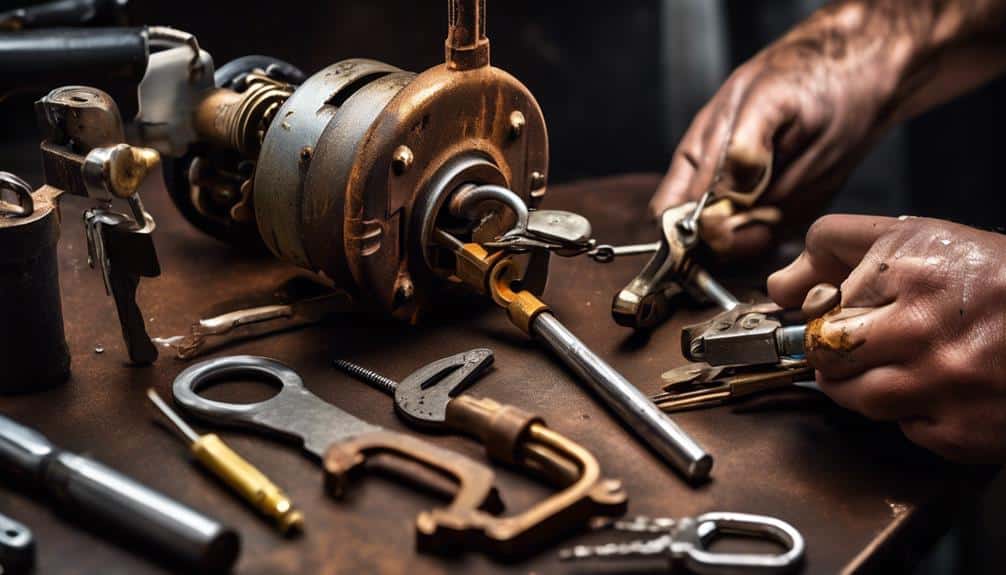Have you ever found yourself struggling with a stubborn lock that just won't budge? Perhaps you've heard whispers of various lock repair solutions, but you're not sure which ones actually work.
Well, fear not! In this discussion, we will explore the truth behind the theory that there are seven best lock repair solutions for stuck locks. From lubricating the lock mechanism to seeking professional locksmith assistance, we will delve into each method and provide you with the knowledge you need to regain access to your stubborn lock.
So, let's uncover the secrets and discover the most effective solutions together.
Lubricating the Lock Mechanism
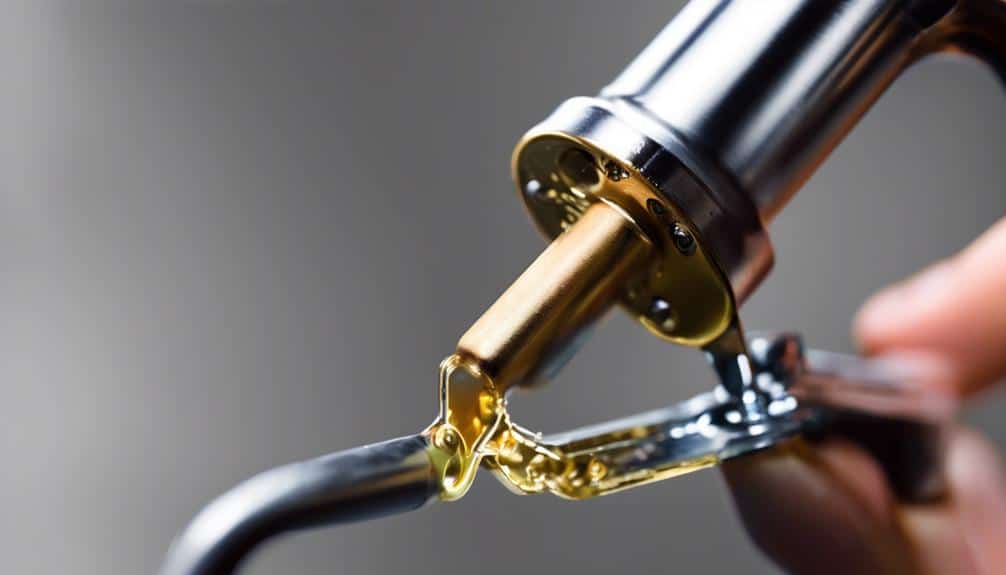
To ensure smooth operation and prevent potential lock malfunctions, it's essential to properly lubricate the lock mechanism. Lock maintenance plays a crucial role in preventing lock jams and ensuring the longevity of your locks. A well-lubricated lock mechanism reduces friction and allows the components to move freely, preventing any hindrances in the locking and unlocking process.
When it comes to lubricating your lock mechanism, it's important to choose the right lubricant. Avoid using oil-based lubricants as they tend to attract dust and debris, which can eventually lead to lock jams. Instead, opt for a dry lubricant or graphite powder specifically designed for locks. These lubricants create a thin, protective layer on the lock components, reducing friction and preventing the accumulation of dirt and grime.
To properly lubricate the lock, start by inserting the key into the lock and turning it back and forth a few times. This will help distribute the lubricant evenly across the internal components. Next, apply a small amount of the chosen lubricant onto the key and insert it into the lock again. Turn the key multiple times to ensure the lubricant reaches all the necessary parts.
Regular lock maintenance, including proper lubrication, is crucial in preventing lock jams and ensuring the smooth operation of your locks. By following these steps, you can keep your locks in excellent condition and avoid any potential lock malfunctions.
Using Graphite Powder for Locks
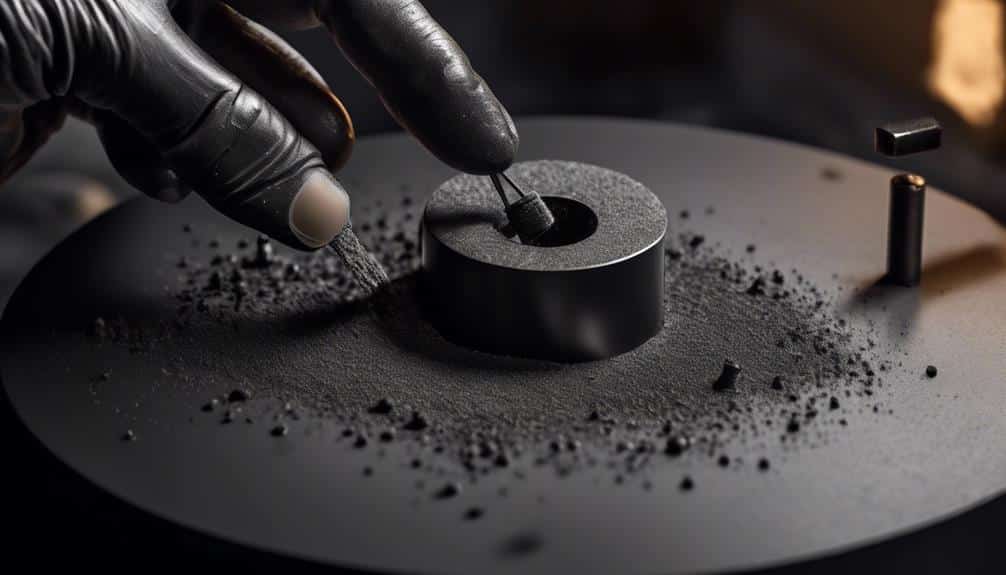
Graphite powder is an effective and recommended lubricant for locks due to its ability to create a smooth and frictionless surface. When it comes to lock maintenance, using graphite powder has several benefits.
Firstly, it helps to reduce friction between the lock's components, allowing for smoother and easier operation. This is particularly useful for locks that are stuck or difficult to turn.
Secondly, graphite powder has excellent adhesive properties, which means it adheres well to the lock's internal parts, providing long-lasting lubrication.
Additionally, graphite powder is dry and doesn't attract dust or dirt, unlike oil-based lubricants. This helps to prevent the accumulation of debris that can cause locks to become jammed or malfunction.
When applying graphite powder to stuck locks, there are a few tips to keep in mind. Firstly, ensure that the lock is clean and free from any debris or rust. Use a brush or compressed air to remove any dirt or particles that may be present.
Next, insert the graphite powder into the lock mechanism, either by using a graphite powder applicator or by tapping the lock gently to disperse the powder inside.
Finally, operate the lock several times to distribute the graphite powder evenly and allow it to work its way into the moving parts. Remember to wipe away any excess powder to prevent it from staining surfaces or clothing.
Using graphite powder for lock maintenance is a simple and effective way to keep your locks operating smoothly and prevent them from getting stuck.
Repairing Broken Key in Lock
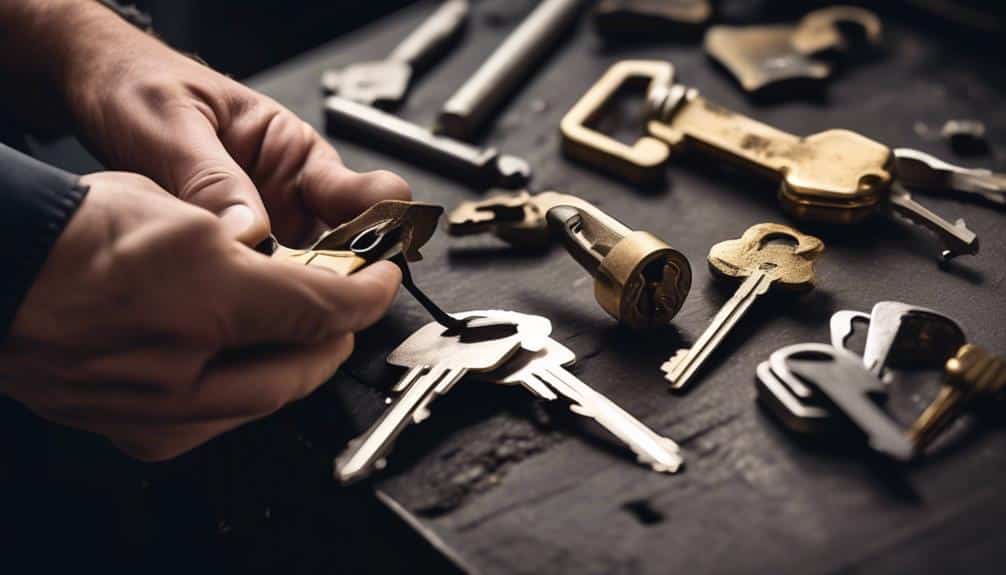
When encountering a broken key in a lock, there are two main solutions: extracting the broken key or rekeying the lock.
Extracting the broken key involves using specialized tools to carefully remove the broken piece from the lock mechanism.
On the other hand, rekeying the lock involves changing the internal pins and springs to fit a new key, rendering the broken key useless.
Both methods require precision and expertise to ensure the lock is properly repaired and functional again.
Extracting Broken Key
Using specialized tools and techniques, you can successfully extract a broken key from a lock, restoring its functionality. When faced with a broken key stuck in a lock, it's best to call for professional locksmith services.
Locksmiths have the necessary skills and expertise to safely and efficiently remove the broken key without causing any further damage to the lock. They use a variety of tools such as broken key extractors, tweezers, and lubricants to carefully extract the key fragment from the lock.
The process involves inserting a key extractor tool into the lock, which hooks onto the broken key, allowing it to be pulled out smoothly. Additionally, locksmiths may use lubricants to ease the removal process and prevent any potential damage.
It's important to rely on experienced locksmiths for extracting broken keys to ensure a successful and hassle-free resolution to the problem.
Rekeying the Lock
To repair a broken key in a lock, one efficient solution is to rekey the lock. Rekeying involves changing the lock mechanism to match a new key, rendering the broken key useless. This process is often performed by locksmith services, who possess the necessary expertise and tools. Rekeying offers a cost-effective alternative to replacing the entire lock, especially if the lock itself is still in good condition. By rekeying the lock, you can ensure the security of your property without the need for extensive repairs.
| Advantages of Rekeying the Lock | Disadvantages of Rekeying the Lock |
|---|---|
| Cost-effective solution | Cannot repair severely damaged locks |
| Quick and efficient process | Requires professional locksmith services |
| Provides enhanced security | May not be suitable for all lock types |
Rekeying the lock is a practical option for those looking to address a broken key situation without the need for a complete lock replacement.
Adjusting Lock Alignment
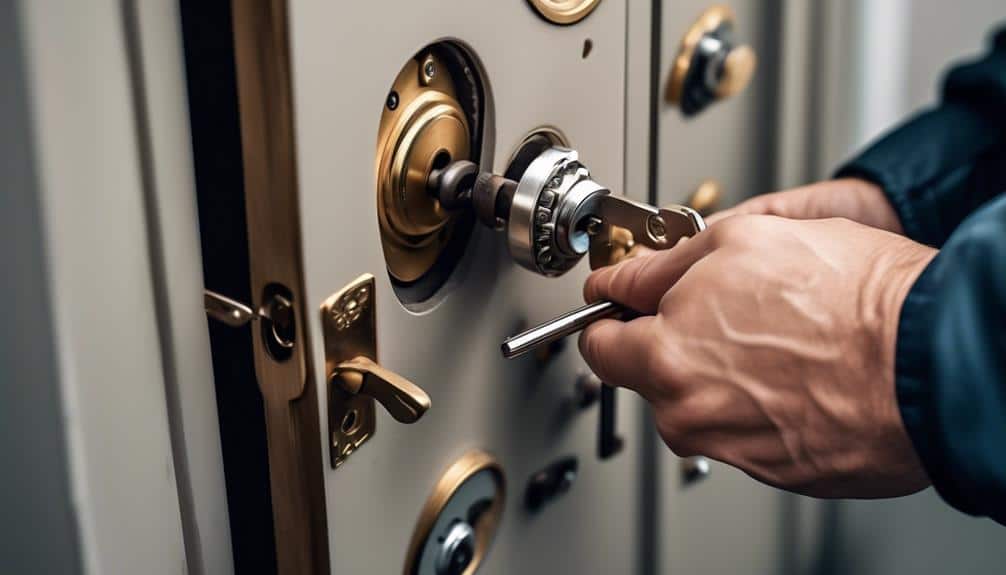
In order to properly align a lock, it's essential to meticulously adjust the internal components ensuring optimal functionality and security. By adjusting the lock alignment, you can resolve common issues such as sticking, jamming, or difficulty turning the key.
Start by examining the lock mechanism to identify any visible signs of damage or misalignment. Inspect the latch, strike plate, and other components for any signs of wear or bending. If you notice any issues, you may need to repair or replace the damaged parts.
To troubleshoot lock alignment issues, begin by loosening the screws on the strike plate and latch. Gradually reposition the strike plate until it aligns perfectly with the latch. Tighten the screws to secure the strike plate in place. Next, adjust the latch by slightly loosening its screws and repositioning it until it fits smoothly into the strike plate. Once aligned, tighten the screws to ensure a secure fit.
If adjusting the strike plate and latch doesn't resolve the alignment problem, you may need to examine the lock cylinder. Remove the lock from the door and disassemble it carefully. Check for any debris or foreign objects that may be obstructing the internal components. Clean the cylinder thoroughly and reassemble the lock, ensuring that all parts are properly aligned.
Replacing Worn Out Lock Cylinder
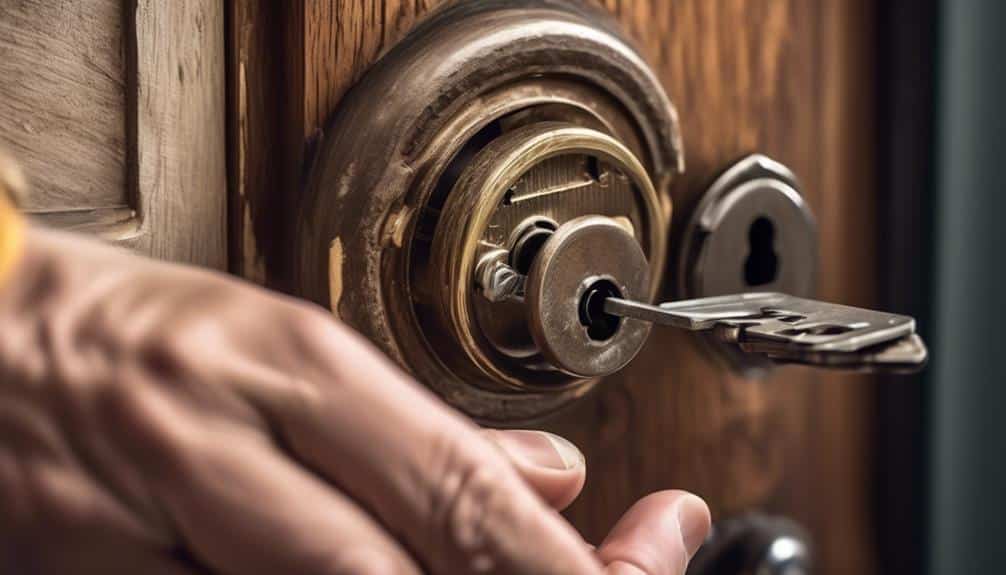
When it comes to replacing a worn out lock cylinder, there are several key points to consider.
First, understanding the cylinder replacement process is essential. This includes removing the old cylinder, selecting the appropriate replacement, and installing it correctly.
Second, knowing the signs of a worn cylinder is crucial in determining when replacement is necessary. Look out for difficulty turning the key, a loose or wobbly lock, or visible signs of wear and tear.
Lastly, having the necessary tools for cylinder replacement is vital. This may include a screwdriver, pliers, a cylinder removal tool, and a new lock cylinder.
Cylinder Replacement Process
You can replace a worn-out lock cylinder by following a detailed and technical process. Before replacing the cylinder, it is important to understand the common problems that can occur with lock cylinders and the importance of regular maintenance. Lock cylinder maintenance includes cleaning and lubricating the cylinder to ensure smooth operation. Common cylinder problems that may require replacement include key sticking, difficulty turning the key, or a lock that fails to engage properly. When replacing a lock cylinder, it is essential to have the right tools and a replacement cylinder that matches the brand and model of your existing lock. The table below provides a step-by-step guide to help you through the cylinder replacement process.
| Step | Description |
|---|---|
| 1 | Gather the necessary tools: screwdriver, pliers, replacement cylinder. |
| 2 | Remove the screws securing the lock faceplate. |
| 3 | Release the cylinder retaining clip or screw. |
| 4 | Pull out the old cylinder. |
| 5 | Insert the new cylinder and secure it in place. |
Following these steps will allow you to replace a worn-out lock cylinder and restore the security of your lock.
Signs of Worn Cylinder
To identify signs of a worn cylinder, it's important to observe the condition of your lock and look for specific indicators that may require the replacement of the lock cylinder. One common sign of a worn cylinder is difficulty in turning the key. If you find yourself struggling to insert or turn the key smoothly, it could be a clear indication that the lock cylinder is worn out.
Another sign to watch out for is a loose or wobbly key when inserted into the lock. This could mean that the cylinder pins are no longer properly aligned, potentially leading to lock malfunctions.
Additionally, if you notice any visible signs of damage or rust on the lock cylinder, it's crucial to address it promptly to prevent further deterioration.
Tools for Cylinder Replacement
In order to successfully replace a worn out lock cylinder, it's essential to have the proper tools at your disposal.
When it comes to lock cylinder replacement, there are a few key tools that you'll need. Firstly, you'll require a cylinder removal tool. This tool is designed to safely and efficiently remove the cylinder from the door.
Additionally, you'll need a set of lock picks. These picks will allow you to manipulate the pins inside the lock cylinder, making it easier to remove and replace. It's important to note that different lock cylinder types may require different lock picking techniques. Therefore, it's crucial to have a variety of lock picks on hand to accommodate for these variations.
Removing Rust From Locks

Rust can be effectively eliminated from locks using various methods and cleaning solutions. If you're facing a rusted lock, don't worry, as there are simple DIY solutions to help you restore its functionality. Before starting the rust removal process, it's important to ensure rust prevention in the future. Applying a thin layer of lubricant, such as WD-40 or graphite powder, can help prevent rust from forming.
To remove rust from a lock, begin by spraying a rust dissolver, like PB Blaster or WD-40 Rust Remover, directly onto the affected areas. Allow the solution to sit for a few minutes to penetrate the rust. Then, use a wire brush or toothbrush to scrub away the rust. Be sure to reach all the nooks and crannies of the lock mechanism. After scrubbing, wipe away any excess solution and rust debris with a clean cloth.
For stubborn rust, you can also try soaking the lock in white vinegar or lemon juice overnight. These acidic solutions can help dissolve the rust and make it easier to remove. After soaking, rinse the lock with water and dry it thoroughly. Finally, apply a rust-resistant lubricant, such as silicone spray or lock lubricant, to keep the lock functioning smoothly and prevent future rust formation.
Seeking Professional Locksmith Assistance
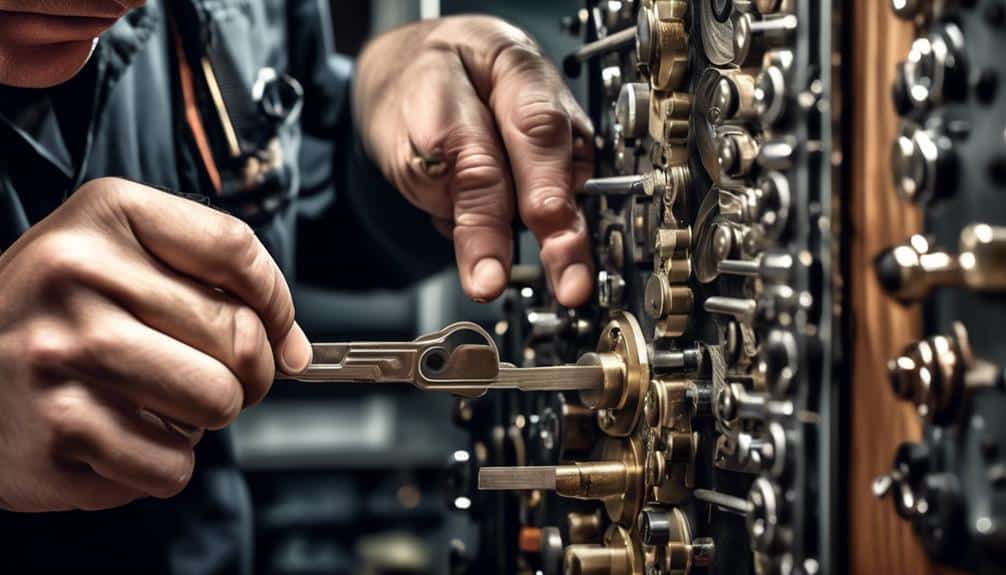
If your lock is still not functioning properly despite attempting to remove the rust, it may be time to seek the assistance of a professional locksmith. Sometimes, DIY techniques may not be enough to fix complex lock issues.
Here are a few reasons why hiring a professional locksmith is the best course of action:
- Expertise: Professional locksmiths have extensive knowledge and experience in dealing with various lock problems. They've undergone rigorous training and possess the necessary skills to diagnose and repair different types of locks.
- Specialized Tools: Locksmiths use specialized tools and equipment that are specifically designed for lock repair. These tools allow them to efficiently and effectively solve lock problems without causing any damage to the lock or surrounding areas.
- Time and Convenience: Hiring a professional locksmith saves you time and effort. Instead of spending hours trying to fix the lock yourself, a locksmith can quickly identify the issue and provide a solution. This saves you from the frustration of dealing with a malfunctioning lock and allows you to focus on other important tasks.
Professional locksmiths are well-versed in the common lock problems that homeowners face. By seeking their assistance, you can ensure that your lock is repaired correctly and functions smoothly once again.
Frequently Asked Questions
How Do I Prevent My Lock From Getting Stuck in the First Place?
To prevent your lock from getting stuck in the first place, there are a few things you can do.
First, make sure to keep your lock clean and free of debris.
Regularly lubricating the lock mechanism with a silicone-based lubricant can also help prevent lock jams.
Additionally, avoid using excessive force when operating the lock and be gentle with the key.
If you're still experiencing lock issues, it's best to consult a professional locksmith for troubleshooting and repair.
Can I Use WD-40 Instead of Graphite Powder to Lubricate My Lock?
Using WD-40 instead of graphite powder to lubricate your lock may seem like a quick fix, but it's not the best solution. Graphite powder has several benefits for lock lubrication.
It provides long-lasting lubrication, reduces friction, and doesn't attract dirt and debris.
On the other hand, WD-40 can actually cause more harm than good. It can attract dirt, gum up the lock mechanism, and eventually lead to more sticking.
Stick with graphite powder for effective and reliable lock lubrication.
What Should I Do if I Accidentally Break My Key While It's Still Inside the Lock?
If you accidentally break your key while it's still inside the lock, don't panic. There are ways to safely remove the broken key without causing further damage.
You can use tools such as needle-nose pliers or a broken key extractor to carefully extract the broken key from the lock. It's important to be patient and gentle during this process to avoid any complications.
Once the key is removed, you can then assess the situation and determine if any lock repair solutions are necessary.
Is It Possible to Adjust the Alignment of a Lock Without Calling a Locksmith?
To adjust the alignment of a lock without calling a locksmith, you can try a DIY lock repair approach.
Start by examining the lock's strike plate and latch bolt for any misalignment.
Use a screwdriver to adjust the position of the strike plate, ensuring it aligns with the latch bolt.
You may also need to loosen or tighten the screws on the strike plate and latch bolt for proper alignment.
Remember to test the lock after making adjustments to ensure it's functioning correctly.
How Often Should I Replace the Lock Cylinder to Avoid It Getting Worn Out?
To avoid a worn-out lock cylinder, it's crucial to know when to replace it.
The lifespan of a lock cylinder varies, but generally, it's recommended to replace it every 5-7 years.
Signs of a worn-out lock cylinder include difficulty turning the key, sticking or grinding noises, and keys that frequently get stuck.
Regular maintenance and lubrication can extend its lifespan, but eventually, a replacement will be necessary to ensure your lock's security.

